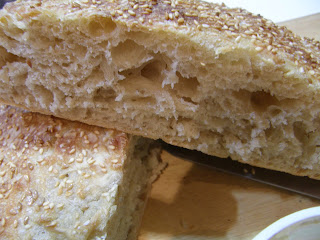

When Living magazine came in I was delighted to find some neat recipes for bread with nice pictures and great detail on how to do it. I decided to make the multigrain boule. The loaf was somewhat overdone and the crust was thicker than it should be. The flavor was not as expected. The bread was dense and relatively tasteless. My wife didn't like it either. Since I should not eat bread, I gave it to the birds.
Here is the recipe for multigrain boule.
For the preferment, make the day before:
4 ounces bread flour (1 cup)
2 ounces rye flour (1/2 cup)
2 ounces whole wheat flour (1/2 cup)
1/4 tsp active dry yeast
12 ounces cool water (75 to 78 deg F; 1-1/2 cups)
Stir the preferment ingredients together in a medium bowl. Cover with plastic wrap and let stand at room temperature for 12 to 15 hours.
For the dough
12 ounces bread flour (3 cups)
2 ounces rye flour (1/2 cup)
2 ounces whole wheat flour (1/2 cup)
1/4 cup toasted wheat germ
2 Tbs toasted sunflower seeds
2 Tbs toasted sesame seeds
2 Tbs flaxseed
1-1/2 tsp active dry yeast
8 ounces cool water (75 to 78 deg F; 1 cup)
3-1/2 tsp sea salt
Vegetable oil cooking spray
Make the dough. Whisk together the flours, wheat germ, seeds, and yeast. [No salt yet.] Add water and preferment. Stir together until the mixture comes together in a ball of dough. Cover the bowl with plastic wrap and let stand for 20 minutes.
Turn the dough out onto an unfloured work surface. Sprinkle with salt.
Knead the dough stretching and folding until the dough is smooth and elastic, about 8 to 10 minutes. Dough will be very sticky, but avoid adding more flour until the end when it may be necessary to add a very small amount. Form dough into a ball.
Place the dough into an oiled bowl. Cover with oiled plastic wrap. Let rise at cool room temperature for 1 hour.
Turn out the dough and stretch and fold once. Stretch the dough into a rectangle. Fold into thirds, then in half. Place back into the bowl. Cover and let rise again for 40 to 50 minutes.
Turn the dough onto lightly flowered work surface. Form a rectangle and then fold into thirds. Roll up tightly and form into a tight round shape. Gather edges and tuck them underneath. Place the dough on the work surface. Cup hands around the dough and rotate it in circles until a smooth, taut ball forms.
Place dough smooth side down into a colander lined with a well floured linen towel. I use a basket sprayed with Crisco oil with flour and heavily floured. Cover with oiled plastic wrap and let rise until doubled, 40 to 50 minutes.
Prepare the oven with the baking stone. place the iron frying pan on the bottom of the oven and prepare 1/2 cup of water to provide steam. Preheat the oven to 425 deg F.
Turn the boule out onto a parchment lined peel. Slash the top of the boule with four slashes like a # sign. I use the tomato knife for this. Slide the bread on the parchment onto the baking stone. Immediately add the water to the hot frying pan. Watch out for the steam. I use a small watering can for this.
Reduce the heat to 400 deg F. Bake for 65 to 75 minutes, rotating half way through the bake period, until the loaf is deep golden brown and the interior is 205 deg F. Let cool on a rack before slicing.
Martha Stewart Living magazine, January 2008, pp 152-4.
Note: The article covers the kneading process in great detail with pictures not included in this recipe.












